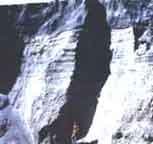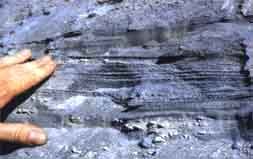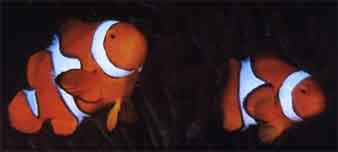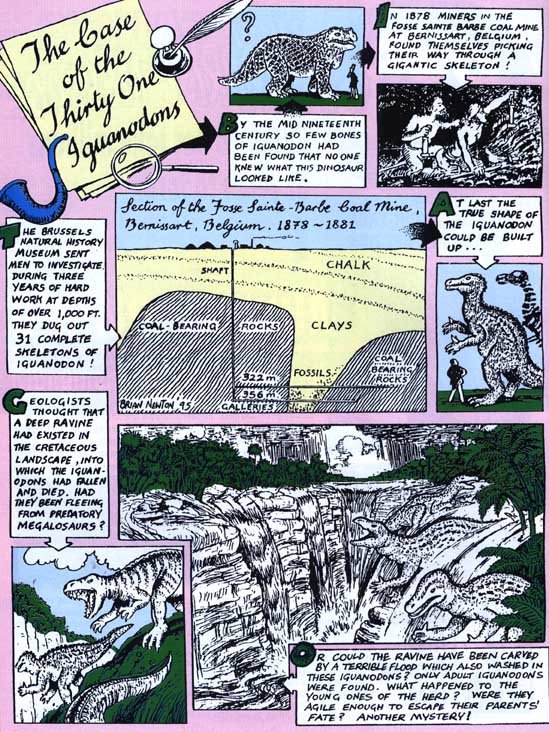Rock Formation and Clownfish
Originally published in Creation 18, no 2 (March 1996): 29-32.
Learn about rock formation, clownfish, God’s awesome power, and more!
Volcano’s Suprise Message … Rocks do not take millions of years

In 1980, after being quiet for 123 years, the Mount St Helens volcano in Washington State, USA, erupted. Soon afterwards, thick layers of mud and ash quickly turned to hard rocks, and scientists had to rethink their ideas about how long rocks take to form.
The photograph at left shows a person standing below a cliff near Mount St Helens. How old is the cliff? Look carefully at the picture, and you will see that there are three separate sections in the cliff. Would you believe that each of these sections was formed in one day? It may sound unbelievable, but it's true! The lower part was formed on May 18, 1980; the centre part, which is 7.5 metres (25 feet) thick, was formed on June 12, 1980, and the darker part at the top on March 19, 1982.
If no one had seen this happen, it may have been thought that this cliff would have taken at least thousands of years to form, but we know it happened very quickly. Altogether, almost 200 metres (600 feet) of rocks have formed at Mount St Helens since 1980! This means that other rocks, which often seem very old, may have been formed quickly, too.


Left: Close view of the June 12 section of the cliff. Many people who study rocks (geologists) had previously believed that thin layers like this each took a year or more to form, by mount St Helens shows that many can be formed together.
Most people also believe that canyons are made very slowly as rivers gradually cut through the hard rocks. But several canyons have formed quickly near Mount St Helens. Above right is Engineers' Canyon, which was formed in one day (March 19, 1982), when a mudflow swept through. The cliff on the right is 30 metres (100 feet) high! This evidence should teach us that things are not always as old as they seem.
Rocks that formed fast
Three-quarters of the earth's surface is covered with rocks that were formed by water (called sedimentary rocks). There is a lot of evidence that they were formed quickly. Sometimes, fossil tree trunks up to 15 metres (45 feet) tall are found standing upright, surrounded by rock. If the rocks had taken thousands or millions of years to form around those trees, the trees would have rotted away long before they could be buried. Recently, geologists on the North Sea coast of England have discovered that soft mud has only taken a few years to turn into hard rock.
There are lots of fossil graveyards around the world, where many different creatures, including dinosaurs, have been preserved in rock. Normally, when an animal dies it quickly rots away, and does not become a fossil. So all the millions of animals in those fossil graveyards had to be buried fast, or they would not be there in the rocks now. The Bible tells us of a world-wide flood which killed all the air-breathing creatures that were not on Noah's Ark. This flood would have dumped lots of mud and sand and buried millions of creatures, including sea creatures, so most of the fossil graveyards are probably the result of that great Flood, which was God's judgment on a wicked world.
The Case of the Thirty One Iguanadons
Tom and Jenny
and the school guinea pig
Gertie, the class guinea-pig, was found dead one morning — of old age. She was nearly four, and had had 28 children. There was a lot of sadness and tears, and a funeral after she was put in a gold chocolate box, and was then buried under a bush beside the school — with a wreath made of daisies.
Afterwards, the practical Ralph asked, 'Miss Wright, will Gertie become a fossil?'
'No, I don't think she will,' the teacher replied, 'but what do you think will happen?'
'I don't want worms to eat her,' sobbed little Rachel.
'Not earthworms, but what would happen if the bodies of all the animals that ever died were still lying around?'
'Oh dear! There wouldn't be any space! They'd be metres deep — the earth couldn't go on, could it?' exclaimed Jenny. 'They have to go somehow!'
'Yes,' replied Miss Wright, 'there are tiny creatures, and especially bacteria, which reduce the bodies to simpler substances which can be used again by plants when they are taken up in solution by the roots. Some larger creatures help too. We see pictures of vultures and think them very ugly, but they clear away dead animals, and so prevent disease — like nature's garbage collectors. Some insects lay their eggs in bodies left above the ground and the grubs soon eat them away. There are even burying beetles, which dig away underneath until things like a dead bird or mouse are buried and covered up. Then they lay their eggs.'
'You know how all the fallen leaves and garden rubbish make good compost,' Miss Wright continued. 'Earthworms chew old leaves, then pull them down into their burrows. Sometimes you see big leaves sticking up out of the lawn. Worms have pulled the stalks down, but can't pull the rest until it gets softer.' So you see, everything is used again. Nothing is wasted in nature.'
RECYCLING
Tom was thinking hard. 'God doesn't like waste. He has arranged for everything to be recycled.'
'We are only just beginning to catch up on recycling with our bottle banks and can collections,' agreed Miss Wright. 'We are still wasteful with our packaging — in fact, we are often called the "throwaway society". We must all be careful not to throw away anything that could be of use.'
'Some children I know threw food around at a party,' said Babs. 'My Mum said it was a wicked waste.'
'So it was, and very rude,' said Miss Wright. 'I hope it was no one here.'
'No, it was some older children. We give all our leftovers to our chickens, and they give us eggs.'
Tom spoke up: 'I always thought it was unnecessary to gather up the leftover fish and bread when Jesus fed the 5,000 people, because He could just as easily have made some more, but I suppose He was teaching us not to waste food.'
'There are 30 of us here,' said Miss Wright. 'If we are all careful all our lives not to throw away anything useful, that will be a good lesson Gertie guinea-pig has taught us, won't it?
They all agreed.
Weird and Wonderful
Clownfish

Clownfish don't behave like clowns, but they get their name from their bright orange and white markings. These small fish live very strange lives, for they live among the stinging tentacles of sea anemones (pronounced a-NEM-o-neez).
Sea anemones are normally deadly to other fish, which only have to accidentally touch one of the stinging tentacles to be killed, and are then eaten by the anemone. Yet the clownfish actually swim in among those tentacles without being harmed! People once believed that they somehow managed to do this without touching the tentacles, but it is now known that they rub against them. The clownfish even dart among them for safety if a larger fish is chasing them.
If clownfish are taken away from sea anemones, they are soon eaten by other fish. So they depend on their special friendship with the anemones. But how do they avoid being killed? Scientists think they have found the answer.
All fish are covered in mucus, which makes them feel slimy, and there is an amino acid in this mucus which triggers the sea anemone's tentacles. But clownfish don't have this amino acid! This colourful fish is another of nature's wonders which evolution cannot explain. God must have designed these two sea creatures to get along together.
God doesn't need TIME!

Most people believe the earth is millions of years old, because that is what they have been told. But there is a lot of evidence that the earth is only thousands of years old. We have seen that rocks can be formed very quickly, and that living things have to be buried quickly to become fossils. In the Bible we read that 'In six days the Lord made everything. He made the sky, earth, sea and everything in them' (Exodus 20:11). And the Bible shows us that this was only a few thousand years ago. God is so powerful that He doesn't need lots of time to create things; He only has to speak!
When God came to earth in the person of the Lord Jesus Christ, He performed miracles, like raising the dead Lazarus back to life, and stilling a storm on the Sea of Galilee. And He did these instantly, with a word! Jesus showed us the way that God works, and what a powerful Creator He is. We can be sure that God could easily create the world and the universe in six days. In fact, we may wonder why He took so long! The Bible also tells us that one day time will come to an end. After that will be eternity, which lasts for ever. God wants us to live for ever with Him, by believing in Jesus His Son, who died and rose again to bring us forgiveness. The Bible says: 'You should look for the Lord before it is too late. You should call to him while he is near' (Isaiah 55:6). Don't put it off until tomorrow — put your faith in Jesus today!
None
BrowseRecommended Resources
- © 2024 Answers in Genesis
- Privacy Policy
- Contact
- About





